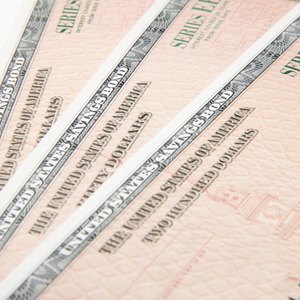
U.S. savings bonds are intended to be long-term savings vehicles. However, sometimes getting some cash is a priority, and a series EE bond can be a ready source of cash. You can redeem a savings bond as soon as one year after purchase and receive the money the same day.
Series EE Redemption Restrictions
You cannot cash or redeem series EE savings bonds during the first 12 months after purchasing them. If you cash a bond after the first year but before the bond is 5 years old, you will incur an interest penalty. The penalty will be the most recent three months worth of interest earnings. After a savings bond is 5 years old, you can redeem it at any time for the current value of the bond. The amount of money you receive is based on the interest rate the bond has earned and the initial investment amount.
Savings Bond Maturity
Series EE savings bonds have two dates, which can be considered as maturity dates. The final maturity date of a savings bond is 30 years after issue. At that point, a savings bond will stop earning interest and has reached its final value. A second maturity date for series EE bonds is the time frame for a bond to double in value. EE bonds are guaranteed to double after a certain period of years. As of publication, new series EE bonds were guaranteed to double the original investment amount in no more than 20 years.
Denomination Value
A series EE bond owner must be aware that the savings bond was purchased for one-half the listed denomination value. For example, a $500 savings bond initially cost $250 and earns interest to grow toward the $500 denomination. It will take the bond up to 20 years to reach a value of $500. If you cash a bond early, the money you receive could be significantly less than the face value. At the time of publication, a $500 series EE bond issued 5 years earlier had a redemption value of $300.20.
Redemption Considerations
A new series EE savings bond is guaranteed to double in value in 20 years. If a bond has not earned enough interest to double, the Treasury will make a one-time interest credit to the bond's value on the 20-year anniversary. If a you redeem a bond a few months before the 20-year point, you may miss out on a significant amount of interest. Also, savings bonds grow tax deferred. When you cash a bond, the earned interest becomes taxable and you will receive an IRS Form 1099 for the interest earned on the bond.
References
- Treasury Direct: Redeem EE/E Savings Bonds and Savings Notes
- TreasuryDirect.gov. "Series I Savings Bonds." Accessed Feb. 7, 2020.
- TreasuryDirect.gov. "Tax Considerations for I Bonds." Accessed Feb. 7, 2020.
- TreasuryDirect.gov. "Series I Savings Bonds FAQs." Accessed Feb. 7, 2020.
- TreasuryDirect.com. "Treasury Inflation-Protected Securities (TIPS)." Accessed Feb. 7, 2020.
Writer Bio
Tim Plaehn has been writing financial, investment and trading articles and blogs since 2007. His work has appeared online at Seeking Alpha, Marketwatch.com and various other websites. Plaehn has a bachelor's degree in mathematics from the U.S. Air Force Academy.

